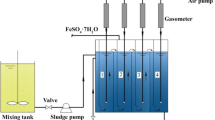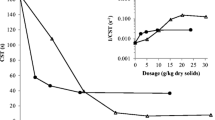Abstract
Fenton conditioning processes have been recently employed to improve the dewaterability of sewage sludge. However, it remains unclear whether the conditioning with Fenton’s reagent would simultaneously attenuate antibiotic resistance genes (ARGs) in sludge and improve sludge dewaterability. It was found in the present study that sludge pre-acidification played a pivotal role in simultaneously removing ARGs and improving sludge dewaterability by conditioning with Fenton’s reagent. When the sewage sludge was pre-acidified to pH = 3.0 and was then conditioned using Fenton’s reagent, the absolute abundances of the total ARGs and the total mobile genic elements (MGEs) in conditioned sludge were reduced by 1.85–2.10 and 2.84–3.12 log units, respectively. Additionally, sludge capillary suction time (CST) and specific resistance to filtration (SRF) were drastically reduced, and the moisture content (MC) in dewatered sludge cake was reduced to only 60.61–69.95%. Such effective attenuation of ARGs and MGEs in conditioned sludge led to their removal in both the dewatered sludge cakes and dewatering filtrate. However, only the improvement of sludge dewaterability was attained by sludge conditioning with Fenton’s reagent but without sludge pre-acidification. During the conditioning treatment, the removal of loosely bound extracellular polymeric substance (EPS) and tightly bound EPS in conditioned sludge contributed to the improvement of sludge dewaterability, and the damage of sludge microbial cells was highly correlated with the attenuation of antibiotic resistance. Thus, sludge pre-acidification combined with conditioning using Fenton’s reagent can be employed to simultaneously attenuate the antibiotic resistance in sewage sludge and improve sludge dewaterability.





Similar content being viewed by others
Data of availability
Not applicable.
References
APHA, AWWA, WEF (2012) Standard methods for examination of water and wastewater. An Hidrol Médica 5:185–186. https://doi.org/10.5209/rev_ANHM.2012.v5.n2.40440
Burch TR, Sadowsky MJ, LaPara TM (2014) Fate of antibiotic resistance genes and class 1 integrons in soil microcosms following the application of treated residual municipal wastewater solids. Environ Sci Technol 48:5620–5627. https://doi.org/10.1021/es501098g
Burch TR, Sadowsky MJ, LaPara TM (2017) Effect of different treatment technologies on the fate of antibiotic resistance genes and class 1 integrons when residual municipal wastewater solids are applied to soil. Environ Sci Technol 51:14225–14232. https://doi.org/10.1021/acs.est.7b04760
Cai M, Wang Q, Wells G, Dionysiou DD, Song Z, Jin M, Hu J, Ho SH, Xiao R, Wei Z (2019) Improving dewaterability and filterability of waste activated sludge by electrochemical Fenton pretreatment. Chem Eng J 362:525–536. https://doi.org/10.1016/j.cej.2019.01.047
Duan WJ, Gao JF, Zhang WZ, Wang YW, Liu J (2020) Elimination of antibiotic resistance genes in waste activated sludge by persulfate treatment during the process of sludge dewatering. Bioresour Technol 311:123509. https://doi.org/10.1016/j.biortech.2020.123509
Feng L, Luo J, Chen Y (2015) Dilemma of sewage sludge treatment and disposal in China. Environ Sci Technol 49:4781–4782. https://doi.org/10.1021/acs.est.5b01455
Gherghel A, Teodosiu C, De Gisi S (2019) A review on wastewater sludge valorisation and its challenges in the context of circular economy. J Clean Prod 228:244–263. https://doi.org/10.1016/j.jclepro.2019.04.240
He DQ, Chen JY, Bao B, Pan XL, Li J, Qian C, Yu HQ (2020) Optimizing sludge dewatering with a combined conditioner of Fenton’s reagent and cationic surfactant. J Environ Sci (China) 88:21–30. https://doi.org/10.1016/j.jes.2019.08.009
He DQ, Wang LF, Jiang H, Yu HQ (2015) A Fenton-like process for the enhanced activated sludge dewatering. Chem Eng J 272:128–134. https://doi.org/10.1016/j.cej.2015.03.034
He DQ, Zhang YJ, He CS, Yu HQ (2017) Changing profiles of bound water content and distribution in the activated sludge treatment by NaCl addition and pH modification. Chemosphere 186:702–708. https://doi.org/10.1016/j.chemosphere.2017.08.045
He P, Zhou Y, Shao L, Huang J, Yang Z, Lü F (2019) The discrepant mobility of antibiotic resistant genes: evidence from their spatial distribution in sewage sludge flocs. Sci Total Environ 697:134176. https://doi.org/10.1016/j.scitotenv.2019.134176
Karkman A, Do TT, Walsh F, Virta MPJ (2018) Antibiotic-resistance genes in waste water. Trends Microbiol 26:220–228
Liu H, Yang J, Shi Y, Li Y, He S, Yang C, Yao H (2012) Conditioning of sewage sludge by Fenton’s reagent combined with skeleton builders. Chemosphere 88:235–239. https://doi.org/10.1016/j.chemosphere.2012.02.084
Liu H, Yang J, Zhu N, Zhang H, Li Y, He S, Yang C, Yao H (2013) A comprehensive insight into the combined effects of Fenton’s reagent and skeleton builders on sludge deep dewatering performance. J Hazard Mater 258–259:144–150. https://doi.org/10.1016/j.jhazmat.2013.04.036
Lu Y, Xiao Y, Zheng G et al (2020) Conditioning with zero-valent iron or Fe2+ activated peroxydisulfate at an acidic initial sludge pH removed intracellular antibiotic resistance genes but increased extracellular antibiotic resistance genes in sewage sludge. J Hazard Mater 386:121982. https://doi.org/10.1016/j.jhazmat.2019.121982
Lu Y, Zhang C, Zheng G, Zhou L (2018) Improving the compression dewatering of sewage sludge through bioacidification conditioning driven by Acidithiobacillus ferrooxidans: dewatering rate vs. dewatering extent. Environ Technol (United Kingdom) 40:1–14. https://doi.org/10.1080/09593330.2018.1465129
Lu Y, Zheng G, Wu W, Cui C, Zhou L (2017) Significances of deflocculated sludge flocs as well as extracellular polymeric substances in influencing the compression dewatering of chemically acidified sludge. Sep Purif Technol 176:243–251. https://doi.org/10.1016/j.seppur.2016.12.016
Lu Y, Zheng G, Zhou W, Wang J, Zhou L (2019) Bioleaching conditioning increased the bioavailability of polycyclic aromatic hydrocarbons to promote their removal during co-composting of industrial and municipal sewage sludges. Sci Total Environ 665:1073–1082. https://doi.org/10.1016/j.scitotenv.2019.02.174
Meng X, Yan S, Wu W, Zheng G, Zhou L (2017) Heterogeneous Fenton-like degradation of phenanthrene catalyzed by schwertmannite biosynthesized using: Acidithiobacillus ferrooxidans. RSC Adv 7:21638–21648. https://doi.org/10.1039/c7ra02713c
Munir M, Wong K, Xagoraraki I (2011) Release of antibiotic resistant bacteria and genes in the effluent and biosolids of five wastewater utilities in Michigan. Water Res 45:681–693. https://doi.org/10.1016/j.watres.2010.08.033
Pepper IL, Brooks JP, Gerba CP (2018) Antibiotic resistant bacteria in municipal wastes: is there reason for concern? Environ Sci Technol 52:3949–3959. https://doi.org/10.1021/acs.est.7b04360
Sharmila VG, Kumar SA, Banu JR, Yeom IT, Saratale GD (2019) Feasibility analysis of homogenizer coupled solar photo Fenton process for waste activated sludge reduction. J Environ Manag 238:251–256. https://doi.org/10.1016/j.jenvman.2019.03.013
Urra J, Alkorta I, Mijangos I, Epelde L, Garbisu C (2019) Application of sewage sludge to agricultural soil increases the abundance of antibiotic resistance genes without altering the composition of prokaryotic communities. Sci Total Environ 647:1410–1420. https://doi.org/10.1016/j.scitotenv.2018.08.092
Vikesland PJ, Pruden A, Alvarez PJJ, Aga D, Bürgmann H, Li XD, Manaia CM, Nambi I, Wigginton K, Zhang T, Zhu YG (2017) Toward a comprehensive strategy to mitigate dissemination of environmental sources of antibiotic resistance. Environ Sci Technol 51:13061–13069. https://doi.org/10.1021/acs.est.7b03623
Wei H, Gao B, Ren J, Li A, Yang H (2018) Coagulation/flocculation in dewatering of sludge: a review. Water Res 143:608–631
Wu D, Huang Z, Yang K, Graham D, Xie B (2015) Relationships between antibiotics and antibiotic resistance gene levels in municipal solid waste leachates in Shanghai, China. Environ Sci Technol 49:4122–4128. https://doi.org/10.1021/es506081z
Xiao K, Chen Y, Jiang X, Yang Q, Seow WY, Zhu W, Zhou Y (2017) Variations in physical, chemical and biological properties in relation to sludge dewaterability under Fe (II) – oxone conditioning. Water Res 109:13–23. https://doi.org/10.1016/j.watres.2016.11.034
Xiao K, Pei K, Wang H, Yu W, Liang S, Hu J, Hou H, Liu B, Yang J (2018) Citric acid assisted Fenton-like process for enhanced dewaterability of waste activated sludge with in-situ generation of hydrogen peroxide. Water Res 140:232–242. https://doi.org/10.1016/j.watres.2018.04.051
Xiao Y, Lu Y, Zheng G, Zhou L (2019) Impact of initial sludge pH on enhancing the dewaterability of waste activated sludge by zero-valent iron-activated peroxydisulphate. Environ Technol 3330:1–14. https://doi.org/10.1080/09593330.2019.1707880
Xie WY, McGrath SP, Su JQ et al (2016) Long-term impact of field applications of sewage sludge on soil antibiotic resistome. Environ Sci Technol 50:12602–12611. https://doi.org/10.1021/acs.est.6b02138
Xue G, Jiang M, Chen H, Sun M, Liu Y, Li X, Gao P (2019) Critical review of ARGs reduction behavior in various sludge and sewage treatment processes in wastewater treatment plants. Crit Rev Environ Sci Technol 49:1623–1674. https://doi.org/10.1080/10643389.2019.1579629
Yu W, Wen Q, Yang J, Xiao K, Zhu Y, Tao S, Lv Y, Liang S, Fan W, Zhu S, Liu B, Hou H, Hu J (2019) Unraveling oxidation behaviors for intracellular and extracellular from different oxidants (HOCl vs. H2O2) catalyzed by ferrous iron in waste activated sludge dewatering. Water Res 148:60–69. https://doi.org/10.1016/j.watres.2018.10.033
Yu W, Yang J, Shi Y, Song J, Shi Y, Xiao J, Li C, Xu X, He S, Liang S, Wu X, Hu J (2016) Roles of iron species and pH optimization on sewage sludge conditioning with Fenton’s reagent and lime. Water Res 95:124–133. https://doi.org/10.1016/j.watres.2016.03.016
Zhang H, Yang J, Yu W, Luo S, Peng L, Shen X, Shi Y, Zhang S, Song J, Ye N, Li Y, Yang C, Liang S (2014) Mechanism of red mud combined with Fenton’s reagent in sewage sludge conditioning. Water Res 59:239–247. https://doi.org/10.1016/j.watres.2014.04.026
Zhang W, Yang P, Yang X, Chen Z, Wang D (2015) Insights into the respective role of acidification and oxidation for enhancing anaerobic digested sludge dewatering performance with Fenton process. Bioresour Technol 181:247–253. https://doi.org/10.1016/j.biortech.2015.01.003
Zhang Y, Li A, Dai T, Li F, Xie H, Chen L, Wen D (2018) Cell-free DNA: a neglected source for antibiotic resistance genes spreading from WWTPs. Environ Sci Technol 52:248–257. https://doi.org/10.1021/acs.est.7b04283
Zhen G, Lu X, Wang B, Zhao Y, Chai X, Niu D, Zhao T (2014) Enhanced dewatering characteristics of waste activated sludge with Fenton pretreatment: effectiveness and statistical optimization. Front Environ Sci Eng 8:267–276. https://doi.org/10.1007/s11783-013-0530-3
Zhen G, Lu X, Zhao Y, Chai X, Niu D (2012) Enhanced dewaterability of sewage sludge in the presence of Fe(II)-activated persulfate oxidation. Bioresour Technol 116:259–265. https://doi.org/10.1016/j.biortech.2012.01.170
Zheng G, Lu Y, Wang D, Zhou L (2019) Importance of sludge conditioning in attenuating antibiotic resistance: removal of antibiotic resistance genes by bioleaching and chemical conditioning with Fe[III]/CaO. Water Res 152:61–73. https://doi.org/10.1016/j.watres.2018.12.053
Zheng G, Zhou L, Wang S (2009) An acid-tolerant heterotrophic microorganism role in improving tannery sludge bioleaching conducted in successive multibatch reaction systems. Environ Sci Technol 43:4156. https://doi.org/10.1021/es803062r
Zhou X, Jiang G, Wang Q, Yuan Z (2014) A review on sludge conditioning by sludge pre-treatment with a focus on advanced oxidation. RSC Adv 4:50644–50652
Funding
This study received financial support from the National Natural Science Foundation of China (21976091, 21637003).
Author information
Authors and Affiliations
Contributions
JJW: methodology, investigation, data curation, validation, writing—original draft, and writing—review and editing; XQM: methodology and investigation; YC: methodology and investigation; GYZ: conceptualization, methodology, writing—original draft, writing—review and editing, and funding acquisition; LXZ: conceptualization and funding acquisition.
Corresponding author
Ethics declarations
Conflict of interest
The authors declare that they have no competing interests.
Ethical approval and consent to participate
Not applicable.
Consent to publish
All the authors have agreed for authorship, read and approved the manuscript, and given consent for submission and subsequent publication of the manuscript.
Additional information
Responsible Editor: Vítor Pais Vilar
Publisher’s note
Springer Nature remains neutral with regard to jurisdictional claims in published maps and institutional affiliations.
Supplementary Information
ESM 1
(DOCX 321 kb)
Rights and permissions
About this article
Cite this article
Wang, J., Meng, X., Chen, Y. et al. Simultaneously attenuating antibiotic resistance genes and improving the dewaterability of sewage sludge by conditioning with Fenton’s reagent: the pivotal role of sludge pre-acidification. Environ Sci Pollut Res 28, 13300–13311 (2021). https://doi.org/10.1007/s11356-020-11562-w
Received:
Accepted:
Published:
Issue Date:
DOI: https://doi.org/10.1007/s11356-020-11562-w




